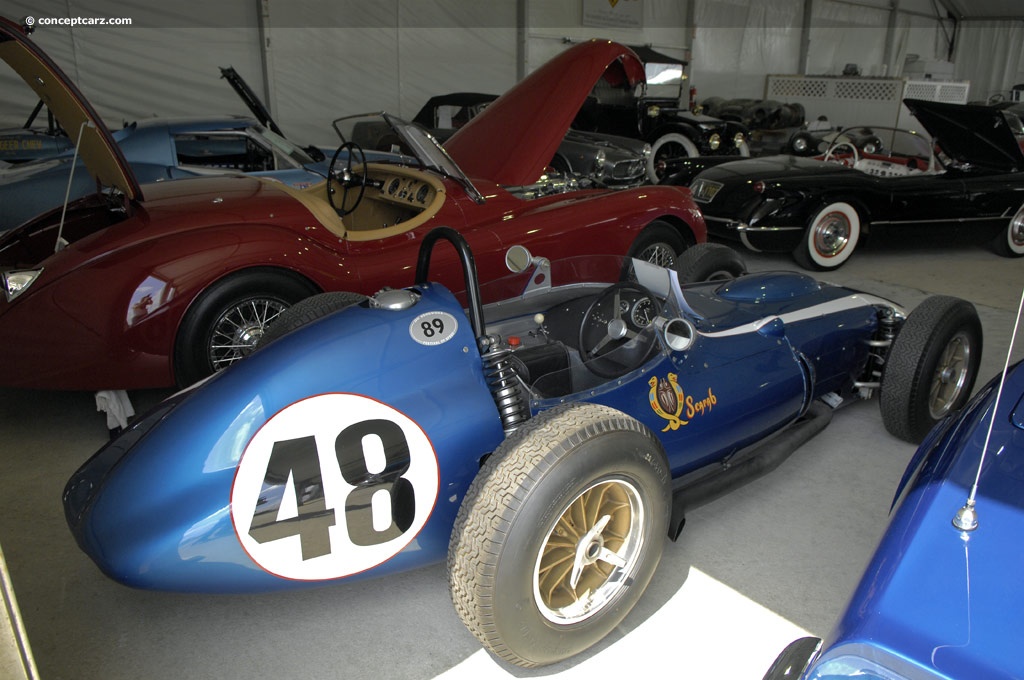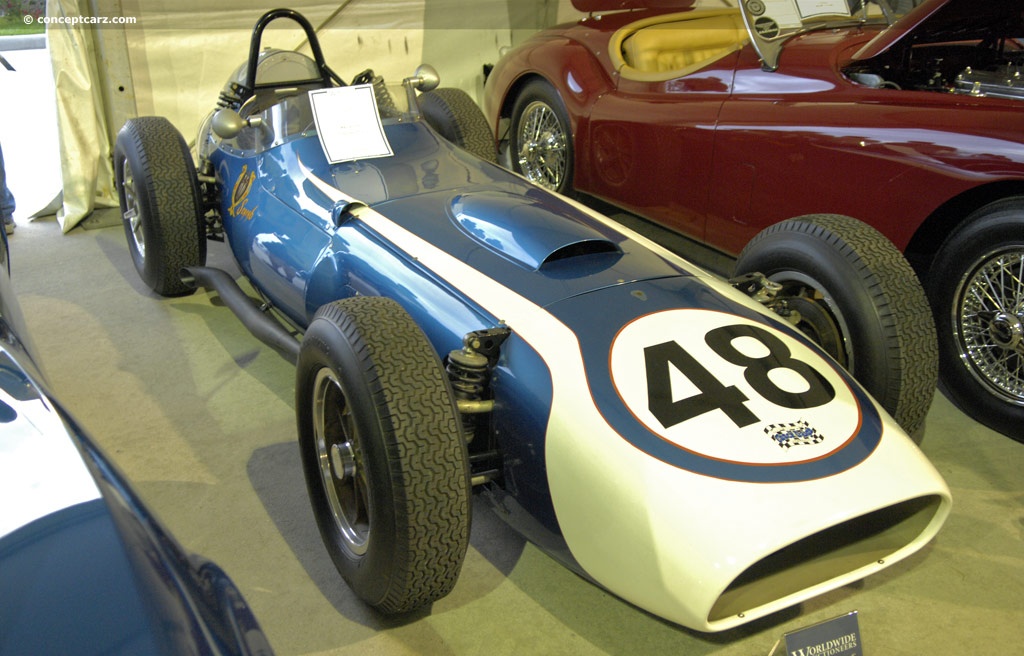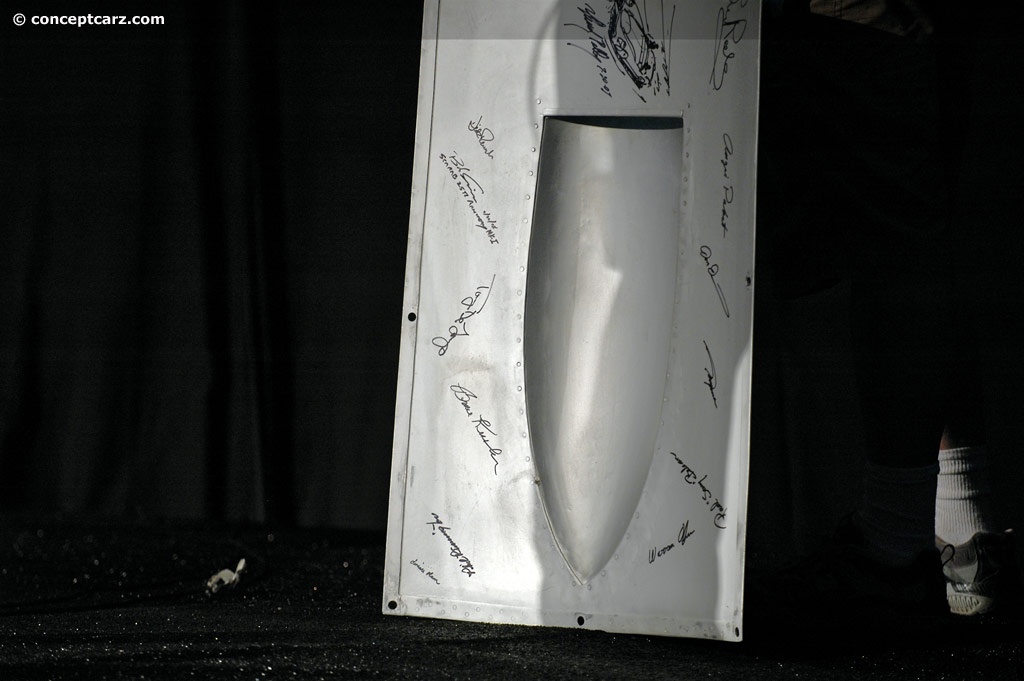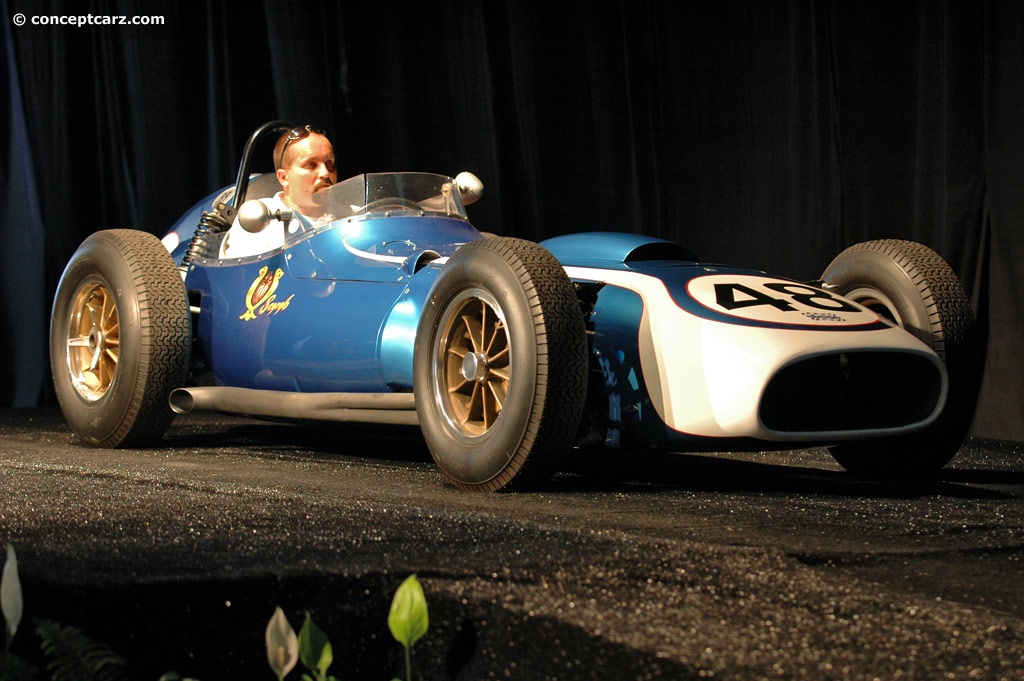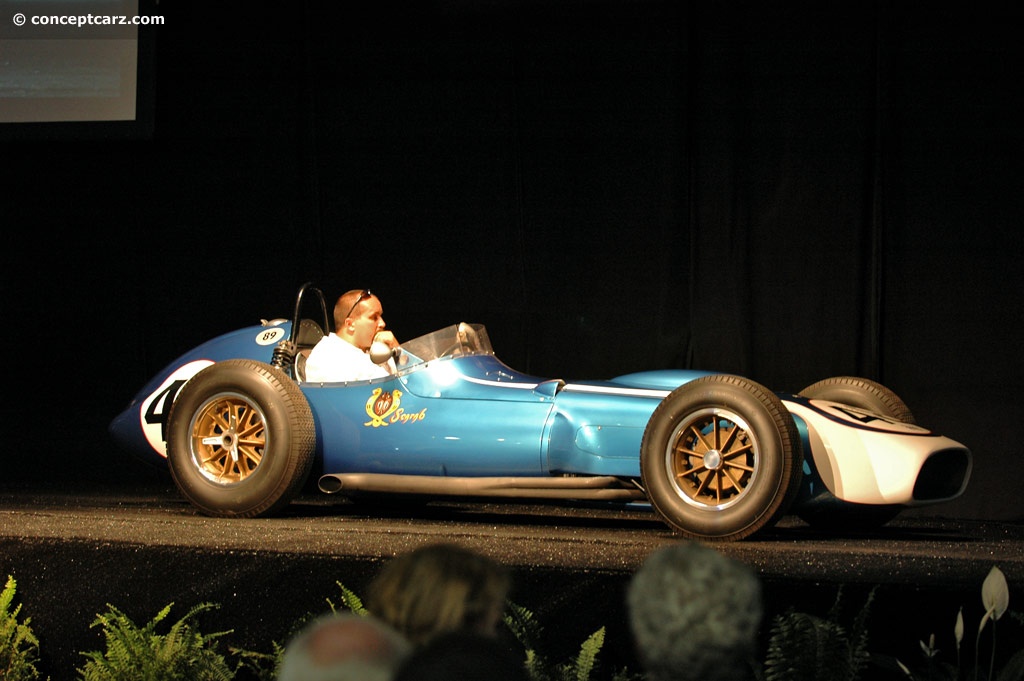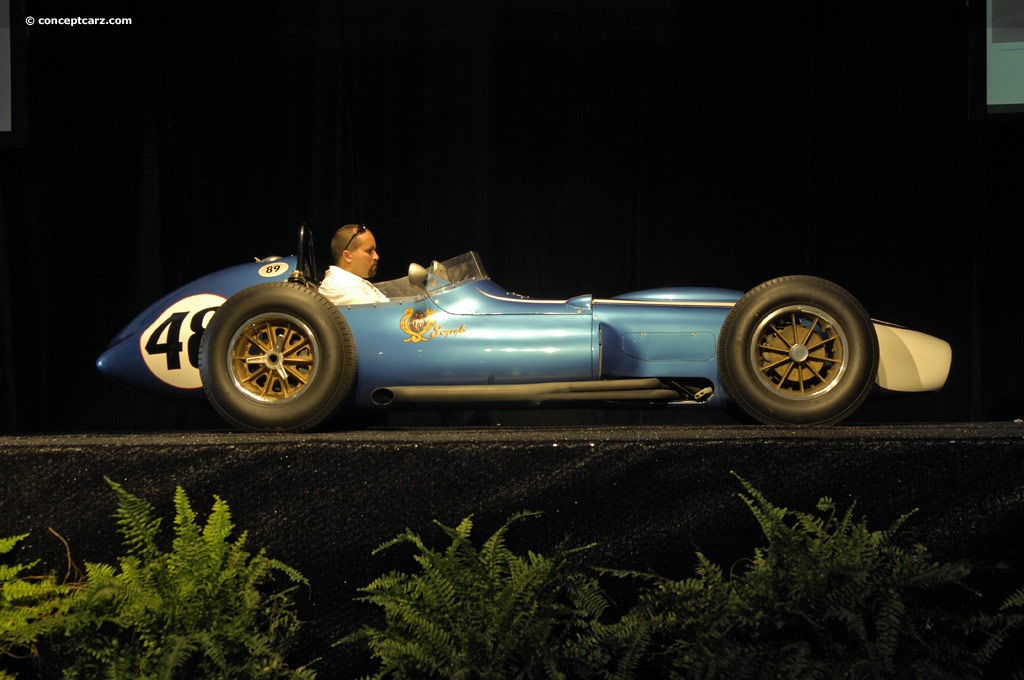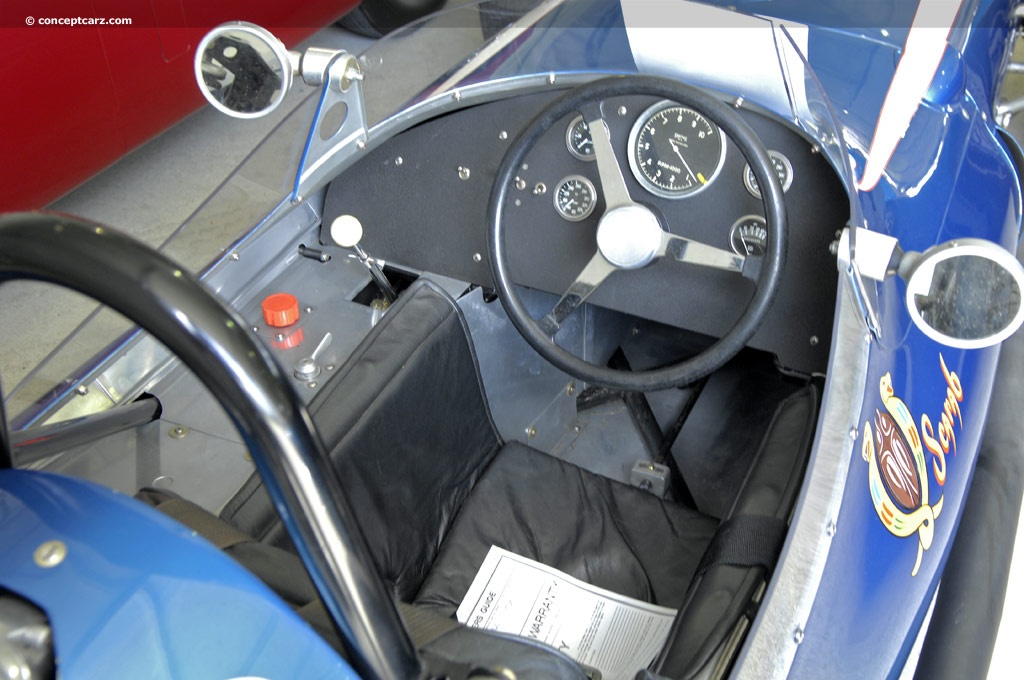Image credit: © conceptcarz.com (Reproduction Or reuse prohibited).
Detroit was producing a new generation of lightweight, large displacement pushrod overhead valve V8 engines that soon found their way into the bellies of race cars produced by hot rodders, tuners, and road racers. They had proven their merit in Cadillacs, Oldsmobiles, and Chryslers and would even breath new life into tired Ferraris and Maseratis. With refined engineering and improved casting techniques, it seemed like the possibilities were virtually endless. The engine, coupled with a proper chassis, such as the ones produced by builders like Brian Lister in the UK and Bill Sadler in Canada, soon became a dominant force in racing.
Lance Reventlow was born in 1936, the son of Woolworth heiress Barbara Hutton and Danish Count Kurt von Haugwitz-Reventlow. Needless to say, he was born of considerable wealth, even after his parents divorced he was a man of considerable means. By the early 1930s, he fostered a passion for automobile racing. That interest blossomed even further when he met Bruce Kessler, another individual with considerable riches and a knack for the mechanical inter-workings of automobiles. The duo raced cars in Europe and America, visiting factories and gathering techniques on how to build a successful racing machine. After this tour, Reventlow was convinced that he could assemble an American team to build and race a competitive car. Warren Olsen was charged with the management of the team, Emil Diedt and Phil Remington were the fabricators, and Jim Travers and Frank Coon managed the engines. Chuck Pelly drew the body lines and Ken Miles contributed his insights, concepts, and practical experience. Chuck Daigh filled in wherever he was needed and took the cars out for test drives. Reventlow wrote the checks.
The first attempt at making this dream a reality was the Scarab MK1. It was a fast car that showed tremendous promise. It was soon followed by another Scarab, the MKII. In total, three examples of both the MK1 and MKII combined were created.
The Chevy V8-powered Scarab sports racers soon dominated the U.S. Road Racing Championship and overwhelmed their competition in style, construction, and presentation. In 1958, the Scarabs attempted international racing but the FIA ruled their big Chevy V8s out of competition, restricting sports cars to three liters. Lance Reventlow sold the Scarab sports cars and focused his attention on Formula One.
Entering Formula One was a very ambitious undertaking. Their vehicle employed untested technologies but was rooted in a conventional front-engine rear-drive layout. From the start, Reventlow had insisted upon the four-cylinder layout, designed to lay over on its side as was the fashion in Indy Roadsters. This setup had been tested and proven both in Grand Prix and in American oval racing, and if the design had stopped there it might have been implemented successfully. But Reventlow chose desmodromic valve operation, which had been a dream of engine designers for many years. In concept, it positively mechanically controlled valve closing and opening through two cams, and permitted precise control of valve operation, at theoretically unlimited engine speeds and free from concern for valve spring rates and reliability. The technology had been used in the Mercedes-Benz W196 GP cars the 300 SLR sports racer in the mid-Fifties, and in use in GP motorcycles in a 2-liter OSCA.
The ambitious project undertaken by Reventlow Automobiles, Inc. (RAI) took nearly a year just to get the engine running and wasn't until 1960, the last year of the 2.5-liter formula (for 1961 regulations changed allowing decreasing engine capacity to 1.5-liters), that it even got to the track. The new and untested front-engined GP car sat amongst a field of mid-engined Lotuses, Coopers, BRMs, and Ferraris.
The Scarab F1 was not ready in time for the 1960 season-opening race in Argentina. It had been designed for the 1959 season and had it been ready for that season, it may have been competitive. As fate would have it, it was racing against cars that were more advanced and refined.
Its inaugural racing debut would come later, at Monaco. Reventlow offered Stirling Moss, who was driving a mid-engined Lotus 18 in the race, a chance to drive the Scarab. Moss's talents behind the wheel masked the front-engine Scarab's many shortcomings and proved it had potential. For the Belgian GP at Spa-Francorchamps two weeks later, the Scarab F1's performance had improved. Reventlow blew an engine on the opening lap but Daigh was able to qualify despite vibration problems. Daigh completed sixteen laps before the engine threw a rod. At the French GP at Rheims, Richie Ginther took Lance Reventlow's seat. Again, both cars had engine troubles and the team went home to devote more time to developing the engine.
The team returned to F1 competition in November at Riverside. This time, only one Scarab was entered and was the focus of the entire team. The car was piloted by Chuck Daigh and qualified 18th. It would finish the race in a respectable tenth place. Again, the car had shown that it had potential, but this time it was too little too late. For the 1961 season, the GP formula changed rules to 1.5-liters. The three Scarab F1 chassis were modified to comply with the rules, including one with an Offenhauser engine which Chuck Daigh finished sixth at the Intercontinental race at Goodwood. At Silverstone, he finished in seventh. At another Silverstone meeting, his car was damaged in the rear of the chassis after he was involved in an accident. The chassis was not salvaged but the rest of the car's pieces were saved by members of the RAI team. In the mid-1980s, restoration was begun. The list of original pieces included the complete front suspension with uprights, control arms, shocks and springs, the original steering rack and anti-sway bars, the right rear suspension upright, springs and shocks, two road wheels, a radiator, and the gas tanks. The entire body, less the tail which had been crushed in the accident, survived in its original condition. Other original parts included its two noses, one long and the other short, both sides, the front cowl and hood, and the cockpit cowling with original mirrors. Ron Kellogg had preserved the desmodromic four-cylinder engine, along with some blueprints and documents.
In 1988, Dick Troutman built a new Scarab frame using the original blueprints and chassis table from the RAI shop. Chuck Daigh supervised the assembly and worked on perfecting the operation of the desmodromic valve gear. He refined the settings to tighten up the valves with result that the engine resulted in better compression and an increase in horsepower to 265.
After the restoration process was complete, it was displayed, raced, and demonstrated at important events including Amelia Island, the New York and Bagatelle Louis Vuitton Concours, and at the Goodwood Festival of Speed where it was driven by Brian Redman, Damon Hill, and Chuck Daigh.
This vehicle is Scarap GP-2 and is the only one to race at both the United States Grand Prix and the Gran Prix of Monaco. The 2.5-liter dual overhead cam four-cylinder engine has an alloy block, desmodromic valve actuation, and Hilborn fuel injection. There is a ladder-type four-tube steel chassis with triangulated bays, front-mounted transmission with a quick-change rear differential, four-wheel Girling disc brakes, and four-wheel independent suspension.
In 2009, this 1960 Scarab Grand Prix was offered for sale at the Houston Classic Auction in Seabrook, Texas presented by Worldwide Auctioneers. The car was estimated to sell for $750,000 - $850,000. It is chassis number GP-2 and engine number 2E. Bidding began at around $250,000 and soon escalated to $400,000. It would continue to climb until it reached $450,000, and bidding stopped. This sum was not enough to satisfy the car's reserve and it was left unsold.By Daniel Vaughan | May 2009
Lance Reventlow was born in 1936, the son of Woolworth heiress Barbara Hutton and Danish Count Kurt von Haugwitz-Reventlow. Needless to say, he was born of considerable wealth, even after his parents divorced he was a man of considerable means. By the early 1930s, he fostered a passion for automobile racing. That interest blossomed even further when he met Bruce Kessler, another individual with considerable riches and a knack for the mechanical inter-workings of automobiles. The duo raced cars in Europe and America, visiting factories and gathering techniques on how to build a successful racing machine. After this tour, Reventlow was convinced that he could assemble an American team to build and race a competitive car. Warren Olsen was charged with the management of the team, Emil Diedt and Phil Remington were the fabricators, and Jim Travers and Frank Coon managed the engines. Chuck Pelly drew the body lines and Ken Miles contributed his insights, concepts, and practical experience. Chuck Daigh filled in wherever he was needed and took the cars out for test drives. Reventlow wrote the checks.
The first attempt at making this dream a reality was the Scarab MK1. It was a fast car that showed tremendous promise. It was soon followed by another Scarab, the MKII. In total, three examples of both the MK1 and MKII combined were created.
The Chevy V8-powered Scarab sports racers soon dominated the U.S. Road Racing Championship and overwhelmed their competition in style, construction, and presentation. In 1958, the Scarabs attempted international racing but the FIA ruled their big Chevy V8s out of competition, restricting sports cars to three liters. Lance Reventlow sold the Scarab sports cars and focused his attention on Formula One.
Entering Formula One was a very ambitious undertaking. Their vehicle employed untested technologies but was rooted in a conventional front-engine rear-drive layout. From the start, Reventlow had insisted upon the four-cylinder layout, designed to lay over on its side as was the fashion in Indy Roadsters. This setup had been tested and proven both in Grand Prix and in American oval racing, and if the design had stopped there it might have been implemented successfully. But Reventlow chose desmodromic valve operation, which had been a dream of engine designers for many years. In concept, it positively mechanically controlled valve closing and opening through two cams, and permitted precise control of valve operation, at theoretically unlimited engine speeds and free from concern for valve spring rates and reliability. The technology had been used in the Mercedes-Benz W196 GP cars the 300 SLR sports racer in the mid-Fifties, and in use in GP motorcycles in a 2-liter OSCA.
The ambitious project undertaken by Reventlow Automobiles, Inc. (RAI) took nearly a year just to get the engine running and wasn't until 1960, the last year of the 2.5-liter formula (for 1961 regulations changed allowing decreasing engine capacity to 1.5-liters), that it even got to the track. The new and untested front-engined GP car sat amongst a field of mid-engined Lotuses, Coopers, BRMs, and Ferraris.
The Scarab F1 was not ready in time for the 1960 season-opening race in Argentina. It had been designed for the 1959 season and had it been ready for that season, it may have been competitive. As fate would have it, it was racing against cars that were more advanced and refined.
Its inaugural racing debut would come later, at Monaco. Reventlow offered Stirling Moss, who was driving a mid-engined Lotus 18 in the race, a chance to drive the Scarab. Moss's talents behind the wheel masked the front-engine Scarab's many shortcomings and proved it had potential. For the Belgian GP at Spa-Francorchamps two weeks later, the Scarab F1's performance had improved. Reventlow blew an engine on the opening lap but Daigh was able to qualify despite vibration problems. Daigh completed sixteen laps before the engine threw a rod. At the French GP at Rheims, Richie Ginther took Lance Reventlow's seat. Again, both cars had engine troubles and the team went home to devote more time to developing the engine.
The team returned to F1 competition in November at Riverside. This time, only one Scarab was entered and was the focus of the entire team. The car was piloted by Chuck Daigh and qualified 18th. It would finish the race in a respectable tenth place. Again, the car had shown that it had potential, but this time it was too little too late. For the 1961 season, the GP formula changed rules to 1.5-liters. The three Scarab F1 chassis were modified to comply with the rules, including one with an Offenhauser engine which Chuck Daigh finished sixth at the Intercontinental race at Goodwood. At Silverstone, he finished in seventh. At another Silverstone meeting, his car was damaged in the rear of the chassis after he was involved in an accident. The chassis was not salvaged but the rest of the car's pieces were saved by members of the RAI team. In the mid-1980s, restoration was begun. The list of original pieces included the complete front suspension with uprights, control arms, shocks and springs, the original steering rack and anti-sway bars, the right rear suspension upright, springs and shocks, two road wheels, a radiator, and the gas tanks. The entire body, less the tail which had been crushed in the accident, survived in its original condition. Other original parts included its two noses, one long and the other short, both sides, the front cowl and hood, and the cockpit cowling with original mirrors. Ron Kellogg had preserved the desmodromic four-cylinder engine, along with some blueprints and documents.
In 1988, Dick Troutman built a new Scarab frame using the original blueprints and chassis table from the RAI shop. Chuck Daigh supervised the assembly and worked on perfecting the operation of the desmodromic valve gear. He refined the settings to tighten up the valves with result that the engine resulted in better compression and an increase in horsepower to 265.
After the restoration process was complete, it was displayed, raced, and demonstrated at important events including Amelia Island, the New York and Bagatelle Louis Vuitton Concours, and at the Goodwood Festival of Speed where it was driven by Brian Redman, Damon Hill, and Chuck Daigh.
This vehicle is Scarap GP-2 and is the only one to race at both the United States Grand Prix and the Gran Prix of Monaco. The 2.5-liter dual overhead cam four-cylinder engine has an alloy block, desmodromic valve actuation, and Hilborn fuel injection. There is a ladder-type four-tube steel chassis with triangulated bays, front-mounted transmission with a quick-change rear differential, four-wheel Girling disc brakes, and four-wheel independent suspension.
In 2009, this 1960 Scarab Grand Prix was offered for sale at the Houston Classic Auction in Seabrook, Texas presented by Worldwide Auctioneers. The car was estimated to sell for $750,000 - $850,000. It is chassis number GP-2 and engine number 2E. Bidding began at around $250,000 and soon escalated to $400,000. It would continue to climb until it reached $450,000, and bidding stopped. This sum was not enough to satisfy the car's reserve and it was left unsold.By Daniel Vaughan | May 2009
2009 Worldwide Auctioneers : The Houston Classic Auction
Pre-Auction Estimates :
USD $750,000-USD $850,000
High Bid (Lot was not sold)
USD $450,000
2005 The Monterey Sports and Classic Car Auction
Pre-Auction Estimates :
USD $350,000-USD $550,000
High Bid (Lot was not sold)
USD $190,000
Recent Sales of the Scarab Grand Prix
(Data based on Model Year 1960 sales)
Scarab Grand Prixs That Failed To Sell At Auction
1960 Scarab Grand Prix's that have appeared at auction but did not sell.
| Vehicle | Chassis | Event | High Bid | Est. Low | Est. High |
|---|---|---|---|---|---|
| 1960 Scarab Formula 1 | GP-2 | 2022 RM Sothebys : Monaco Grimaldi Forum | $800,000 | $1,000,000 | |
| 1960 Scarab Grand Prix car by Reventlow Automobiles Inc | RA1-GP2 | 2016 Rick Cole : Monterey | |||
| 1960 Scarab Grand Prix | GP-2 | 2009 Worldwide Auctioneers : The Houston Classic Auction | $450,000 | $750,000 | $850,000 |
| 1960 Scarab Grand Prix Race Car | GP II | 2005 The Monterey Sports and Classic Car Auction | $190,000 | $350,000 | $550,000 |
Vehicles With Comparable Market Values
Similar sales to the range.
1960 Scarab Grand Prix
• Additional valuation insight and sales data• History
• Specifications
• Image gallery
